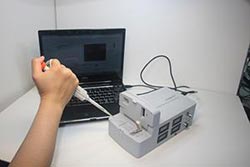Lab-on-a-chip realizes potential

Analyses of liquid samples that once required a full-sized laboratory can now be completed on a disposable plastic chip equipped with narrow fluidic channels and tiny sensors. <br>Copyright : 2013 A*STAR Institute of Materials Research and Engineering <br>
Engineers from the A*STAR Institute of Materials Research and Engineering and colleagues at the University of Basel, Switzerland, have designed and developed a compact, portable analytical instrument that can detect multiple ions and molecules down to a level of 300 parts per billion (ppb) in less than a minute (1).
The machine, based on lab-on-a-chip technology, needs only drop-sized liquid samples. The analysis is very quick, precise and sensitive, and can be performed remotely as no direct contact with the solution is necessary. As such, the device has widespread potential applications in the water, food and beverage, agriculture, environmental, pharmaceutical and medical industries.
“The instrument is now ready for commercialization,” says Kambiz Ansari, who led the research. “In this well-studied field, it is one of only a handful of actual lab-on-a-chip instruments reported so far.”
The easy-to-operate machine, which weighs only 1.2 kg, combines microchip electrophoresis (MCE) with a sensing technology known as a dual capacitively-coupled contactless conductivity detector (dC4D). The system first uses electrophoresis to separate ions and then detects the ions using dC4D. All analyses are performed in microfluidic channels consisting of capillaries inside polycarbonate plastic chips that are narrower than a human hair.
The beauty of the dC4D technology is its simplicity: it relies on remote conductivity measurements via a pair of electrodes. One electrode sends radio-frequency signals through a channel to the second electrode, and the signal received is read by a computer. Because the ions have charge, their resistance drops as they pass through the microfluidic channel, resulting in sudden peaks. Specially designed software then analyzes the data to provide both qualitative and quantitative information.
The instrument has two access compartments (see image). The front compartment houses a plastic chip and a replaceable cartridge detector for the testing; both are designed to eliminate noise. The back compartment houses the electronics and software, the data acquisition card and a battery that powers the instrument for up to 10 hours.
The researchers tested the instrument’s capability to measure inorganic ions in water, rabbit blood and human urine, as well as organic and inorganic acids in fruit juice. They assessed its accuracy against standard methods.
“We have been approached about licensing the technology by several companies active in clinical analyses and in the ornamental fish farm industry,” Ansari says. “And, we are hoping to further develop our system to achieve detection levels lower than 1 ppb by pre-concentrating the samples; we are also planning to introduce nanofluidics into the dC4D system.”
The A*STAR-affiliated researchers contributing to this research are from the Institute of Materials Research and Engineering
Journal information
Ansari, K., Ying, J. Y. S., Hauser, P. C., de Rooij, N. F. & Rodriguez, I. A portable lab-on-a-chip instrument based on MCE with dual top–bottom capacitive coupled contactless conductivity detector in replaceable cell cartridge. Electrophoresis 34, 1390–1399 (2013).
Media Contact
All latest news from the category: Materials Sciences
Materials management deals with the research, development, manufacturing and processing of raw and industrial materials. Key aspects here are biological and medical issues, which play an increasingly important role in this field.
innovations-report offers in-depth articles related to the development and application of materials and the structure and properties of new materials.
Newest articles

Superradiant atoms could push the boundaries of how precisely time can be measured
Superradiant atoms can help us measure time more precisely than ever. In a new study, researchers from the University of Copenhagen present a new method for measuring the time interval,…

Ion thermoelectric conversion devices for near room temperature
The electrode sheet of the thermoelectric device consists of ionic hydrogel, which is sandwiched between the electrodes to form, and the Prussian blue on the electrode undergoes a redox reaction…

Zap Energy achieves 37-million-degree temperatures in a compact device
New publication reports record electron temperatures for a small-scale, sheared-flow-stabilized Z-pinch fusion device. In the nine decades since humans first produced fusion reactions, only a few fusion technologies have demonstrated…





















